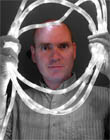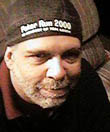|
|
This topic comprises 3 pages: 1 2 3
|
|
Author
|
Topic: Matting
|
|
|
|
|
John Walsh
Film God

Posts: 2490
From: Connecticut, USA, Earth, Milky Way
Registered: Oct 1999
|
 posted 02-05-2000 02:54 PM
posted 02-05-2000 02:54 PM




If I understand your question, then the answer is yes. Scope prints use the full frame, but flat does not, so the projectionist 'mattes' the flat image.But I think you have the terminolgy mixed up. The term 'matte' is used for several things, but for this use, is the black frame placed around the image. Flat has a large area (the black area between the frames) matted. Scope does not. But in both cases, the projector has an aperture plate. That could be thought of as a matte, but it's not called that. If I understand what you are trying to ask... A matte is printed on the film and can not be changed by the projectionist. He changes the aperture plate, and that blocks light from areas of each frame you do not want to see.
| IP: Logged
|
|
|
|
Greg Anderson
Jedi Master Film Handler

Posts: 766
From: Ogden Valley, Utah
Registered: Nov 1999
|
 posted 02-05-2000 03:55 PM
posted 02-05-2000 03:55 PM





The previous film handlers are correct, of course, but I wonder why the question is being asked. The projectionist really doesn't have an option in this. The vast majority of theatres in the United States are made to show just two formats. One is 'scope with just one size of aperture plate and the other is flat with just one size of aperture plate. If the lens isn't matched to the correct aperture, most audience members will notice a problem (which, I hope, means the projectionist will notice too).The question of hard matting and what's really on the film (as opposed to what's intended to be shown in the theatre) becomes more relevant when we're talking about transfering a film to video. Now, if you have more questions about that, it might be a good discussion too. How many projectionists have stopped to examine a "flat" film closely enough to see what's on the film but is NOT within the 1.85 area and is, therefor, not intended to be shown to the public? Usually, you'll just see the occasional microphone, but you might also see that the guy in the shower is really wearing shorts, etc. If the projectionist doesn't get the framing set correctly, the audience can see it too. But rest assured that the filmmakers DO frame for 1.85 in the theatre, whether or not the "full frame" is safe to show in the video version. I tend to like flat films which have a "hard matte" so that even a bone-head projectionist won't frame it incorrectly. I recall that BACK TO THE FUTURE was "full frame" (or, in other words, the image extended both above and below the 1.85 image which the filmmakers wanted the audience to see). In that case, the projector plate masked off the unseen portion. However, all the effects shots which ILM did were hard matted to 1.85 (or something similar. I didn't actually measure the aspect ratio!). As time goes on, filmmakers are more and more conscious of the video transfer while they're shooting the theatrical version. One of the reasons James Cameron is so fond of Super 35 is that it allows him to have an "epic" 2.35 aspect ratio in theatres but then he has the option of extending the top and/or bottom of that frame for a video release, so that the pan-and-scan version doesn't look so horrible. If you compare the "letterbox" versions of Super 35 films to their pan-and-scan versions, you will often see that the pan-and-scan version actually shows more of the original image! It can make you question which version is the best to watch on video.
| IP: Logged
|
|
|
|
|
|
David Koegel
Film Handler
Posts: 55
From: Alexandria, VA
Registered: Jun 99
|
 posted 02-05-2000 08:44 PM
posted 02-05-2000 08:44 PM




I really think Paul's question is innocent and direct enough and I want to take a crack at a complete answer. First off, the use of an aperature plate to block part of a projected image is called matting. The way this is achieved is explained below As mentioned by John, scope prints, squeezed horizontally in a 2:1 ratio, are unsqueezed by that same 2:1 ration (okay, 1:2 ration now) to give a normal looking image upon projection. But an aperature plate IS used here as well for a slight cropping of the image, else things like the sound track will be projected as well, particularly the DTS time code track. Flat prints (which are shot with Spherical lenses, not Panavision lenses, which record the images on the negative squeezed) are normally printed and delivered as full frame images. The projectionists are expected to employ an aperture plate with a 1.85 width-to-height ratio, to block the top and bottom portions of the image, the part which the director didn't expect you to see. If a projector is "framed" wrong, meaning that the image of the film is not correctly centered in the opening of the projector's gate, then you will see part of the image above or below the part the director expected you to see, hence seeing a portion of the "unexpected" part. Also, some prints use 1.66 ratio plates, just to confuse this issue further. Each final projection ratio requires its own lens to give the identical projected image height on the screen, with only the width changing, at least in an ideal situation. Older classics were filmed flat and the images projected were basically the full image from the camera negative, approx 1.37:1. No projection matting is or was employed except like in the case of Scope, with a minor blocking of the image around the edged. Hard matted prints are prints where the image on the final film has been modified so that there is no area above or below the area that the director expected you to see. It could have been done in the camera OR during final printing. Disney animated titles are often hard matted in later reissues even though they were originally shot and projected full frame (nominally 1.33:1). To a film collector, such hard matted prints are less desirable. Afterall, some of the originally-seen image is no longer available to be seen. In my collection, I have "odd reels" of Gone With The Wind that are very different, depending on the year of issue. (Odd Reels are orphan reels that are not presently part of a full set of reels that make up a full feature, typically say 6 reels for a 2 hour movie.) The 1967 domestic print is hard matted. Some of the other reels I have are full frame flat, which is how it was originally printed for final projection, with a camera negative in a 1.37:1 ratio and an expected projection of 1.37:1 ratio (full frame, per www.imdb.com). The 70mm prints were projected 2.20:1, hence slightly cropped. My hard-matted prints were supposed to give the illusion of a wide screen (1.85:1, I think in this case) epic, but all the audience got was a truncated or cropped view of the original movie. Presumably, this was also done so that the projectionist didn't have a chance to project the movie full frame. Why? I just can't fathom a "good" reason here  Well, I've been a bit redundant with respect to earlier postings on this question, and of course this posting is subject to attack, er, correction by others, but that's how you gain an education.  -- David -- David
| IP: Logged
|
|
Aaron Sisemore
Flaming Ribs beat Reeses Peanut Butter Cups any day!

Posts: 3061
From: Rockwall TX USA
Registered: Sep 1999
|
 posted 02-06-2000 01:18 AM
posted 02-06-2000 01:18 AM




Paul:I am assuming you are referring to the electric dowser (more commonly referred to as a changeover, or the most popular trade name "ZipperŪ")... If these are improperly adjusted, gravity can cause the blade of the changeover to fall into the closed position, either partially or fully, obviously messing up the picture... Or it can be caused by a malfunctioning automation or a forgotten cue from another theatre being executed by your automation system causing the changeover to close. The other dowser would be the hand dowser on the lamphouse or console. Depending on the design of the dowser, it can fall closed for many reasons, most of them being things such as a missing or broken spring, linkage or magnet (CFS console hand dowsers have a magnet holding them in the open position). Aaron
| IP: Logged
|
|
John Walsh
Film God

Posts: 2490
From: Connecticut, USA, Earth, Milky Way
Registered: Oct 1999
|
 posted 02-06-2000 01:40 AM
posted 02-06-2000 01:40 AM




A recent example of booms and stuff seen in the frame....I was training a guy, and I switched from flat to scope to show him how things should, and should not look. We were just running trailers, and I had on a flat trailer of "The Bachelor." I changed it to scope, and there was a boom mic right above their heads. That's a recent film; maybe someone still has it. I forget the details now, but there was a serious messup with the film "Going in Style" where lights, boom, all kinds of stuff was visable within the 1.85 (flat) frame. It was so bad, Warners bought everyone running it a new (undercut) aperture plate. Looked crappy on the screen, though. We weren't going to pry the nailed down masking off and reset it for one picture.
| IP: Logged
|
|
|
|
Martin Frandsen
Master Film Handler

Posts: 270
From: Denmark, Europe
Registered: Jun 99
|
 posted 02-06-2000 09:02 AM
posted 02-06-2000 09:02 AM




This is a very interested toppic just wanted to recap:The reason they make hard-matted shots is a money issue. Effects and digital shots are cheaper to make, and animated films dont have to be drawn more than to 1:85, as the film is only 1:85 anyway. But i STILL cant understand why they dont print all 1:85 made films as hard-matted (1:85)  1. It's cheaper (digital/effects shots and animation)
2. Easyer to get the film in frame
3. No microphones etc. will appear All movies shot for 1:85 SHOULD be hard-matted (1:85) at least in the US as 1:85 is your standard ratio. In europe american movies (shot in 1:85) are of cause projected in 1:85 as they should, but 1:66 is more the standard ratio for european film-makers but thats another story. Nightmare before christmas is photographed for 1:66 (please correct me if i am wrong) so the filmmakers can use the extra space still avalibel in the frame. When a filmmaker wants to make a movie in 1:85 then he should make sure that it is also printed hard-matted. The chance that movie will be projected proberly is very high as there is no excuse for not framing a 'matted' movie right. Framing a not-matted flat film CAN be hard (you experts might find that easy but remember i am only a film collector  )the picture is not always printed dead center, so how do you make sure it IS deadcenter? do you use the studio logo at the start of the film to correct in frame? )the picture is not always printed dead center, so how do you make sure it IS deadcenter? do you use the studio logo at the start of the film to correct in frame? AND yes I CAN frame properly as i learnd it here on film-tech in the thread called 'framing question'
 Martin Martin
| IP: Logged
|
|
|
|
Bruce McGee
Phenomenal Film Handler

Posts: 1776
From: Asheville, NC USA... Nowhere in Particular.
Registered: Aug 1999
|
 posted 02-06-2000 10:37 AM
posted 02-06-2000 10:37 AM




I have a 1960 IB 35 print of "All In A Nights Work" On the Holmes, which features a fixed aperture plate (1:37) if I dont frame the image high on the screen, I will be seeing mics, lights, and the occasional body above the stage!I have an awful 1959 16 print of "The Trap." If I dont frame it high, too, the audience gets to see the cut-back roof of a 1957 black Chrysler in every scene shot "in the car" Just for my own amusement, I run both of these films low in the frame so I can see all the "goodies" I love film. It's so adjustable.
| IP: Logged
|
|
|
|
|
|
All times are Central (GMT -6:00)
|
This topic comprises 3 pages: 1 2 3
|
Powered by Infopop Corporation
UBB.classicTM
6.3.1.2
The Film-Tech Forums are designed for various members related to the cinema industry to express their opinions, viewpoints and testimonials on various products, services and events based upon speculation, personal knowledge and factual information through use, therefore all views represented here allow no liability upon the publishers of this web site and the owners of said views assume no liability for any ill will resulting from these postings. The posts made here are for educational as well as entertainment purposes and as such anyone viewing this portion of the website must accept these views as statements of the author of that opinion
and agrees to release the authors from any and all liability.
|

 Home
Home
 Products
Products
 Store
Store
 Forum
Forum
 Warehouse
Warehouse
 Contact Us
Contact Us




 Printer-friendly view of this topic
Printer-friendly view of this topic










 -- David
-- David


 Martin
Martin
 im just kidding of cause, but you get the picture
im just kidding of cause, but you get the picture 


